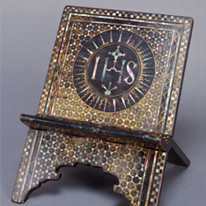Past Exhibitions
- Japanese Export Lacquers: Nanban and Kōmō Wares
- November 26, 2014 - January 12, 2015
During the Momoyama period (1573–1615), Catholic missionaries and traders arriving in Japan on Spanish and Portuguese ships became captivated by the country's durable but exquisite lacquers, which they commissioned for church furnishings as well as for commercial trade goods. These export lacquerwares often had densely spaced patterns covering their surfaces, executed in simple hiramakie (smooth makie patterns made by sprinkling gold and other metallic powders into wet lacquer) and mother-of-pearl inlay. In reference to their nanbanjin ("southern barbarian," a term meaning foreigner) clientele, these works became known as nanban lacquers.
Later in the Edo period (1615–1868), Japan closed itself off from almost all foreign commerce, but it did allow the Dutch and Chinese to trade in Japan, albeit under highly restrictive conditions. The styles of export lacquerware changed accordingly. The new styles made in this period for European clients are called kōmō ("red-haired") lacquers and include high-relief takamakie patterns on black lacquered backgrounds.












